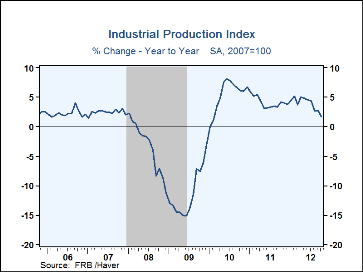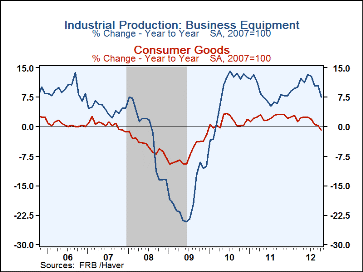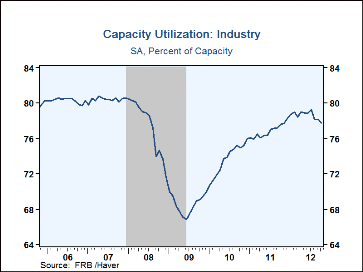 Global| Nov 16 2012
Global| Nov 16 2012U.S. Industrial Output Declines Due To Sandy
by:Tom Moeller
|in:Economy in Brief
Summary
Hurricane Sandy added to last month's weakness in industrial output. Industrial production fell 0.4% during October following a 0.2% September increase, last month reported as 0.4%. A 0.2% increase had been expected. Factory output [...]
 Hurricane Sandy added to last month's weakness in industrial output.
Industrial production fell 0.4% during October following a 0.2% September
increase, last month reported as 0.4%. A 0.2% increase had been expected.
Factory output fell 0.9% after a minimal 0.1% September uptick and utility
output slipped 0.1% (+0.5% y/y). The Fed indicated that industrial
production would have risen roughly 0.6% without the storm and that
factory output would have been unchanged.
Hurricane Sandy added to last month's weakness in industrial output.
Industrial production fell 0.4% during October following a 0.2% September
increase, last month reported as 0.4%. A 0.2% increase had been expected.
Factory output fell 0.9% after a minimal 0.1% September uptick and utility
output slipped 0.1% (+0.5% y/y). The Fed indicated that industrial
production would have risen roughly 0.6% without the storm and that
factory output would have been unchanged.
In manufacturing, the 0.9% (+1.6% y/y) decline in production reflected a 0.9% (-0.9% y/y) drop in consumer goods production. That decline was led by a 2.2% (-5.6% y/y) shortfall in apparel production, a 1.9% (+4.0% y/y) decline in machinery output and a 1.2% (-4.1% y/y) drop in paper production. Furniture output fell 0.6% (+1.0% y/y) and motor vehicles & parts production slipped 0.1% (+10.2% y/y). Industrial output of business equipment fell 1.2% but it still was up 7.5% y/y. Excluding motor vehicles, factory output fell 0.9% (+1.0% y/y). Production of high-tech products worked the other way and rose 1.1% (-1.7% y/y). Outside both of these sectors, factory production was off 1.1% (+1.0% y/y).
Capacity utilization fell to 77.8% from a little revised 78.2% in September. In manufacturing alone, utilization dropped to 75.9% but remained up from the recession low of 64.4%. Overall capacity is estimated to have risen 1.6% y/y following a 0.2% dip last year and a 2.0% decline during 2010. In the factory sector, capacity rose 1.4% y/y and, excluding the high-tech industries, it increased 1.3%.
Industrial production and capacity data are included in Haver's USECON database, with additional detail in the IP database. The expectations figure is in the AS1REPNA database.
Challenges in Housing and Mortgage Markets is the title of yesterday's speech by Federal Reserve Chairman Ben S. Bernanke and it can be found here.
| Industrial Production (SA, % Change) | Oct | Sep | Aug | Oct Y/Y | 2011 | 2010 | 2009 |
|---|---|---|---|---|---|---|---|
| Total Output | -0.4 | 0.2 | -1.1 | 1.8 | 4.1 | 5.4 | -11.4 |
| Manufacturing | -0.9 | 0.1 | -1.0 | 1.6 | 4.3 | 5.7 | -13.8 |
| Consumer Goods | -0.9 | -0.1 | -1.1 | -0.9 | 2.3 | 1.1 | -6.9 |
| Business Equipment | -1.2 | 0.5 | -1.0 | 7.5 | 8.3 | 8.3 | -18.2 |
| Construction Supplies | -0.5 | 0.8 | -0.3 | 2.3 | 5.6 | 3.8 | -22.9 |
| Materials | 0.2 | 0.2 | -1.4 | 2.4 | 4.6 | 8.4 | -11.5 |
| Utilities | -0.1 | 0.0 | -2.1 | 0.5 | -0.3 | 3.6 | -2.5 |
| Capacity Utilization (%) | 77.8 | 78.2 | 78.2 | 77.6 | 76.8 | 73.7 | 68.5 |
| Manufacturing | 75.9 | 76.7 | 76.7 | 75.8 | 75.0 | 71.3 | 65.5 |
Tom Moeller
AuthorMore in Author Profile »Prior to joining Haver Analytics in 2000, Mr. Moeller worked as the Economist at Chancellor Capital Management from 1985 to 1999. There, he developed comprehensive economic forecasts and interpreted economic data for equity and fixed income portfolio managers. Also at Chancellor, Mr. Moeller worked as an equity analyst and was responsible for researching and rating companies in the economically sensitive automobile and housing industries for investment in Chancellor’s equity portfolio. Prior to joining Chancellor, Mr. Moeller was an Economist at Citibank from 1979 to 1984. He also analyzed pricing behavior in the metals industry for the Council on Wage and Price Stability in Washington, D.C. In 1999, Mr. Moeller received the award for most accurate forecast from the Forecasters' Club of New York. From 1990 to 1992 he was President of the New York Association for Business Economists. Mr. Moeller earned an M.B.A. in Finance from Fordham University, where he graduated in 1987. He holds a Bachelor of Arts in Economics from George Washington University.








